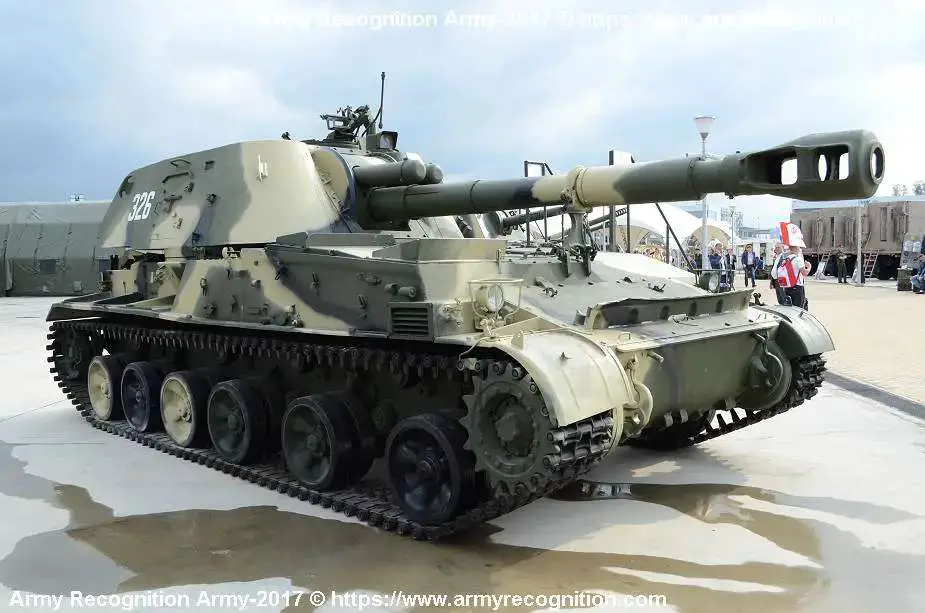Russian Army Receives New 2S3M 152mm Howitzers to Compensate for Losses in Ukraine
On April 5, 2024, ROSTEC, the Russian State Defense Company, confirmed that the Russian army received 2S3M, a modernized version of the 2S3 Akatsia, a 152mm tracked self-propelled howitzer. The move to augment the Russian forces with this state-of-the-art artillery system comes as a response to the escalating demands and to counter the considerable losses of similar equipment in the ongoing conflict in Ukraine.
Follow Army Recognition on Google News at this link

Russian army 2S3M 152mm tracked self-propelled howitzer. (Picture source Army Recognition)
The 2S3M "Akatsia" distinguishes itself with a modernized turret-type howitzer mounted on a high-speed, lightly armored tracked chassis. Designed for optimal mobility and maneuverability, the new Akatsia proves exceptionally capable during the spring thaw and in soft ground conditions, where heavier or wheeled vehicles might falter. This agility ensures that the Akatsia remains elusive and difficult for the enemy to target.
Noteworthy upgrades have been made to this latest model, enhancing its operational efficacy on the battlefield. Among these, the 2S3M now boasts an improved communication system, a higher rate of fire, and an increased ammunition capacity. Originally carrying 40 shells, the 2S3M can now transport 46, supplemented by an external ammunition conveyor for efficient reloading. Furthermore, reliance on imported components has been eliminated, marking a significant step towards self-reliance in military technology.
Another important new feature of the 2S3M is the integration of the 1V514-1 Mechanizator-M automated fire control system, which optimizes targeting and firing processes. The howitzer's self-defense capabilities have also seen an upgrade with the addition of Type 902B Tucha smoke grenade dischargers, offering enhanced protection against enemy detection and targeting.
The 2S3 Akatsiya is a 152mm tracked self-propelled howitzer that entered into service with the Russian army in 1972 and received its first major upgrade to the 2S3M variant in 1975. These howitzers are designed for a range of combat tasks, including the suppression and elimination of enemy forces, artillery, and mortar batteries, as well as command posts and tactical nuclear weapons.
The 2S3 Akatsiya's armament, derived from the D-20 towed howitzer, facilitates a maximum range of 17.4 km with standard ammunition and extends to 20.5 km with rocket-assisted projectiles, maintaining a maximum firing rate of four rounds per minute.
Artillery systems play a pivotal role in the dynamics of the current conflict between Russia and Ukraine, embodying a critical component of Russia's military strategy. The conflict has showcased the evolution and application of artillery in modern warfare, underscoring its significance in achieving tactical and strategic objectives.
The Royal United Services Institute (RUSI) provides insights into how Russia's artillery tactics have adapted throughout the conflict. Initially, Russian artillery units were assigned to support battalion tactical groups, emphasizing mobility. As the conflict evolved into more static fighting, the control of artillery shifted towards centralized artillery brigades to enhance survivability and effectiveness. This shift highlights the adaptability of Russian artillery tactics to the changing dynamics of the conflict.
The development of new artillery tactics, such as the use of shock-fire tactics and reconnaissance-fire systems, demonstrates Russia's commitment to enhancing the precision and lethality of its artillery forces. These tactics leverage modern technology, including UAVs and precision-guided munitions, to deliver highly effective and accurate artillery fire.
Defense News April 2024
- Hits: 4161
















